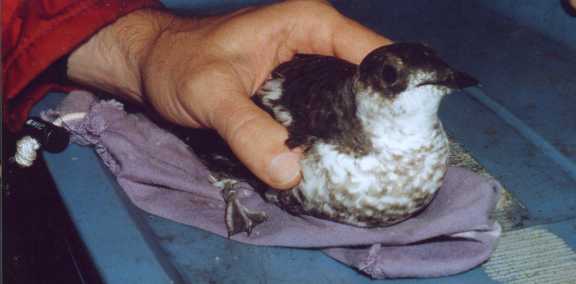 |
|
 |
|


|

|
||||||
North American Marbled Murrelet(Brachyramphus marmoratus) |
|||||||
|
|
|||||||
|
Currently studied by CWE researchers Fred Cooke, David "Dov" Lank, , Laura McFarlane Tranquilla,, Josh Malt, Michael Sivergeiter, Elsie Krebs and Yuri Zharikov. We continue to work with "alumni" of the project, including Falk Huetmann, now at the University of Calgary, and Russell Bradley and Peggy Yen, both now at the Point Reyes Bird Observatory The North American Marbled Murrelet is a small plump (~200g) fast flying seabird belonging to the auk family or Alcidae. At sea they are usually found close to shore and, during the summer months, are easily recognized due to both their distinctive speckled brown breeding plumage and their relatively vocal nature while on the water. During fall the birds undergo a full body and wing moult into winter plumage with contrasting white bellies and dark upperparts. At fledging and through their first winter juveniles resemble winter adults. The year round range of the Marbled Murrelet extends along the pacific coast of North America from the Aleutian Islands to central California. A population of marbled murrelets also occurs on the east coast of Russia and is known as the Asiatic or Long-billed Marbled Murrelet. This form is about 20% heavier than the North American and probably represents a separate species. Marbled Murrelets are quite unique in that, unlike other seabirds in the auk family, they nest solitarily either in trees or on the ground (a small percentage of nests) often many kilometres from water. This solitary and secretive nature has made them a difficult species to study. While the bulk of the North American population is found in Alaska (approximately 75%), large numbers also breed along the coast of British Columbia (approximately 18%), where it appears they are dependant on coastal old-growth type forests, at a range of elevations, for nesting. Although it is difficult to estimate population sizes or trends, there is concern that populations in BC have declined in areas where extensive logging of coastal forests has taken place. Perhaps their greatest current threat is from the ongoing felling of these forests. Additional and as yet unquantified threats include mortality through gill-netting and oil spills at sea. Since 1995 the Centre for Wildlife Ecology has been investigating the nesting habits of the marbled murrelet population in Desolation Sound, BC. During the 2000 season a second study site was established in Clayoquot Sound. Each season teams are involved with the capture and banding of murrelets at sea during the hours between dusk and dawn. A tiny radio transmitter is attached to a sample of birds and this allows us to track these individuals by helicopter and from remote telemetry stations throughout the season. We can determine their individual breeding status, the location of their nests and often the success of each stage of nesting. Also under investigation is the habitat availability in both study sites. Random habitat sites are selected in which to measure those forest characteristics that are also recorded at nest sites. The results from this research will provide us with information on the habitat choices of nesting murrelets by comparing
the habitat that is actually used by the birds with the habitat that is available. Finally, on its own the capture and banding data have enabled the investigation of additional ecological aspects including demographics, marine habitat use and behaviour, all of which are essential for evaluating the effectiveness of conservation efforts in maintaining the population.
|